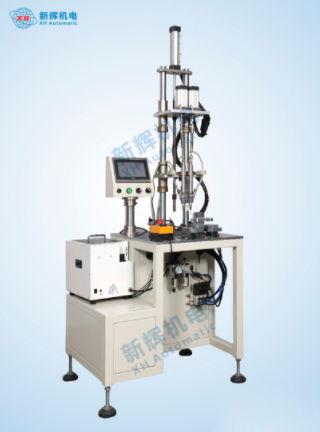Motor motor automatic screwing machine what are the common electrical faults and solutions?
1, power failure
l Failure phenomenon
The machine cannot be started and the power indicator does not light up. This may be due to a damaged power cord, a loose plug or a faulty socket, resulting in the machine not being able to obtain a normal power supply.
After the power supply is turned on, the machine restarts frequently or there are intermittent power failures. This may be due to an unstable power supply, such as excessive voltage fluctuations, or an overly sensitive protective device inside the power supply.
l Solution
First check the power cord for obvious breakage, such as rupture of the outer skin and exposure of the internal wires. If damage is found, the power cord should be replaced. At the same time, make sure that the plug is firmly inserted into the socket and that the socket is working properly. You can test the socket with other electrical equipment.
For unstable power supply, use a voltmeter to measure the input voltage. If the voltage fluctuates beyond the allowable range of the equipment, consider installing a voltage regulator to stabilize the voltage. Also, check whether the power protection device inside the machine is set correctly, and if necessary, adjust it according to the equipment manual.

2. Sensor failure
l Fault phenomenon
The screw tightening position is not detected accurately. For example, the machine may start tightening the screws before they are fully aligned with the screw holes, or it may miss some positions where the screws need to be tightened. This is usually due to a faulty position sensor, such as a photoelectric sensor being blocked, or a magnetic induction sensor being interfered with.
Unable to detect if the screw is tightened. When a screw has been tightened but the machine continues to apply torque, or determines that tightening is complete before the screw has been tightened, this may be a problem with the torque sensor.
l Solution
For position sensors, first check that the sensor is mounted in the correct position and is not loose or displaced. If it is a photoelectric sensor, clean its surface of dust, oil and other pollutants to ensure that the light can be properly emitted and received. For magnetic induction sensors, check whether there is strong magnetic interference around, if there is a source of interference, move it away or shield the sensor.
For torque sensor failure, use a professional torque calibration tool to calibrate the sensor and check whether its output signal is accurate. If the sensor is damaged, replace it with a new torque sensor and recalibrate it after replacement to ensure the accuracy of measurement.
3、Motor and drive failure
l Failure phenomenon
The motor does not rotate or the speed is abnormal. The motor does not rotate may be due to damage to the motor itself, drive failure or problems with the connection line between the motor and the drive. The abnormal rotation speed is manifested in the motor speed is too fast or too slow, and the set screwing speed does not match, which may be the driver's parameter setting error or abnormal power supply of the motor.
Abnormal sound when the motor is running, such as humming, harsh friction sound, etc. This may be the internal parts of the motor are damaged. This may be due to the damage of the internal parts of the motor, such as worn bearings, short-circuiting of the windings, or the failure of the mechanical connection part of the motor, such as loose couplings, damaged transmission gears, etc.
l Solution
Check whether the connection line between the motor and the driver is firm, and whether there is any broken or short circuit. If the connection is normal, use a multimeter to measure the resistance value of the motor winding to determine whether the motor is damaged. For drive failure, you can check the drive's fault indicator, according to the status of the indicator to find the cause of the failure, such as overcurrent, overload, etc., and follow the instructions of the drive. If the motor or drive is damaged, the corresponding parts should be replaced.
When the motor makes an abnormal sound, first cut off the power supply to prevent the fault from expanding. Then disassemble the motor shell and check the bearings, windings and other parts inside the motor. If the bearings are found to be worn, the bearings should be replaced; for short-circuiting of the windings, the windings need to be rewound or the motor needs to be replaced. At the same time, check the mechanical connection part of the motor, tighten the loose coupling or replace the damaged transmission gear.
4、Controller failure
l Fault phenomenon
The program runs chaotically, such as screwing the screws in the wrong order, repeat screwing or skipping some steps. This may be the controller's program error, such as the program was mistakenly modified, program memory chip damage or electromagnetic interference.
The controller is unable to communicate with other devices, e.g. it cannot receive commands from the host computer or cannot transmit work data to other devices. This may be due to communication interface failure, such as the serial port, USB port, Ethernet port, etc. are damaged, or the communication protocol is set incorrectly.
l Solution
For cases where the program is running chaotically, try restarting the machine to see if it can return to normal. If the problem still exists, check whether the program has been modified. If it has been modified by mistake, restore the correct program. If you suspect that the program memory chip is damaged, try to re-burn the program or replace the memory chip. At the same time, check whether there is a strong electromagnetic interference source around the controller, such as large motors, high-frequency equipment, etc., move the interference source away or shield the controller.
When the controller can not communicate with other devices, first check whether the connection of the communication interface is firm, whether the interface has signs of damage. If the interface is normal, check the settings of the communication protocol to ensure that the baud rate, data bits, stop bits, check bits and other parameters of both devices are consistent. You can use communication test tools for testing, such as serial port debugging assistant, in order to find the specific cause of communication failure. If the communication interface is damaged, the corresponding interface module should be replaced.
5. Line failure
l Fault phenomenon
The electrical wiring inside the machine is short-circuited, broken or poor contact. Short-circuit may lead to fuse blowing or damage to electrical components; disconnection will make the signal or power can not be transmitted normally, resulting in partial failure; poor contact will cause signal instability or intermittent interruption of the work of the device.
l Solution
Check the wiring carefully to see if there is a short circuit with broken wire sheath and two wires in contact with each other. For the short-circuited part, repair the broken wires and rewire the line to avoid contact between the wires. Check the connection points of the wiring, such as plugs, sockets, terminals, etc., for looseness, oxidation or corrosion. If there is poor contact, clean the oxidization of the connection points, retighten the connection points, or replace the damaged plugs, sockets, terminals, etc. For disconnected wiring, use a multimeter to find the point of disconnection and reconnect or replace the damaged wires.
※ If the above ways and means still can not solve the equipment failure, please contact Xinhui Electromechanical Equipment Co., Ltd. through the page chat tool to seek help.







